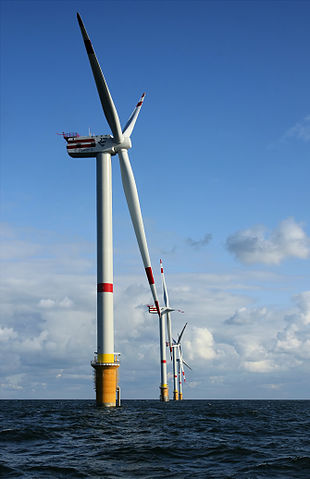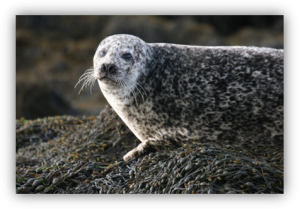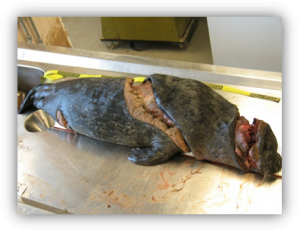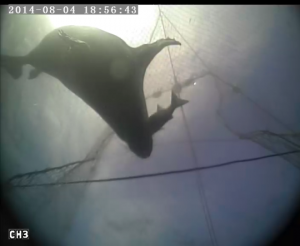Reports to Scottish Government
Marine Mammal Scientific Support Research Programme
In 2015 SMRU completed a major strategic marine mammal research project funded by the Scottish Government, with additional support from Scottish National Heritage (SNH), which provides advice to Scottish Ministers and stakeholders across a range of key marine policy areas (the Marine Mammal Scientific Support Research Programme MMSS/001/11). The programme comprised four major themes: Marine renewable energy, harbour seal decline, unexplained seal deaths, and seal and salmon interactions.
A summary of the major findings can be found here.
- Marine Renewable Energy
- Harbour (or Common) Seal Decline
- Unexplained Seal Deaths
- Seal and Salmon Interactions
To complete the research SMRU worked with a number of collaborating organisations, including the Joint Nature Conservation Committee (JNCC), the Department for Energy and Climate Change (DECC), the Natural Environment Research Council (NERC), the Department for Food and Rural Affairs (Defra), and the Scottish Association for Marine Science (SAMS).
The final reports associated with this research programme can be found below. The Executive Summary from each report can be viewed separately and the reports downloaded as PDFs.
-
Marine Renewable Energy (MR)
Windmills D1-D4 (Thornton Bank) © Hans Hillewaert / CC-BY-SA-4.0
The focus of this research theme was the possible impact of offshore marine renewable energy developments on marine mammals. Potential interactions between seals and cetaceans and various tidal, wind and wave devices were evaluated. An investigation into suitable mitigation measures was also included. This project recognised the need to progressively improve both marine mammal assessment and monitoring methods as well as management approaches to help minimise any apparent adverse effects.
-
MR1&2 Mapping out the current marine renewables research landscape and an assessment of the data gaps with regards to marine mammals
Current state of knowledge of effects of offshore renewable energy generation devices on marine mammals & research requirements. Update, September 2014
Report Summary
-
MR3 Developing methods for tracking the fine scale underwater movements of marine mammals around tidal devices
Methods for tracking fine scale underwater movements of marine mammals around marine tidal devices
Report Summary
-
MR4 Advising regulators and regulatory bodies on specific issues relating to marine renewable energy devices as they arise
Provision of an advice function to support regulators and appropriate regulatory bodies on matters concerning marine mammals
Report Summary
-
MR5 Grey and harbour seal density maps
Grey and harbour seal density maps
Report Summary
-
MR5.1 At-sea usage and activity
At-sea usage and activity
Report Summary
-
MR5.2 Activity classification using state space modelling
Activity classification using state space modelling
Report Summary
-
MR5.4 Inter-haul-out transition rates
Inter-haul-out transition rates
Report Summary
-
MR6.1 Review of methodology and main results of the JCP analysis of cetacean densities in the context of marine renewable development
Review of methodology and main results of the JCP analysis of cetacean densities in the context of marine renewable development
Report Summary
-
MR6.2 Definition of "range" in the context of marine renewable energy development and marine mammal conservation
Definition of "range" in the context of marine renewable energy development and marine mammal conservation
Report Summary
-
MR 7.1.1 Quantifying porpoise depth distributions and underwater behaviour in tidal rapids areas
Quantifying porpoise depth distributions and underwater behaviour in tidal rapids areas
Report Summary
-
MR 7.1.2 The density and behaviour of marine mammals in tidal rapids
The density and behaviour of marine mammals in tidal rapids
Report Summary
-
MR 7.2.1 Collision Risk: a brief review of available information on behaviour of mammals and birds in high tidal energy areas
Collision Risk: a brief review of available information on behaviour of mammals and birds in high tidal energy area
Report Summary
-
MR 7.2.2 Collision risk and impact study: Examination of models for estimating the risk of collisions between seals and tidal turbines
Collision risk and impact study: Examination of models for estimating the risk of collisions between seals and tidal turbines
Report Summary
-
MR 7.2.3 Collision risk and impact study: Field tests of turbine blade-seal carcass collisions
Collision risk and impact study: Field tests of turbine blade-seal carcass collisions
Report Summary
-
MR 8.1 Tests of acoustic signals for aversive sound mitigation with harbour seals
Tests of acoustic signals for aversive sound mitigation with harbour seals
Report Summary
-
MR 8.2 Sound Exposure Explorer Tool Manual
Sound Exposure Explorer Tool Manual
Report Summary
-
-
Harbour* Seal Decline
*Also known as common
Significant declines in many harbour seal populations on the east and north coasts of Scotland were first identified following aerial surveys carried out in 2006. The numbers of animals hauled out on land during their annual moult in August are counted by the SMRU. The dramatic reduction in the number of animals seen during these counts has caused concern, particularly in Shetland and Orkney where up to 60% of the animals have been lost and in the Firth of Tay where over a 90% decline in numbers has been observed.
This research theme provided an update on the potential causes of the decline and priorities for future research; discussed management and potential mitigation options; determined the diet of Scottish common compared to grey seals (whose populations in Scotland are not declining) and investigated the dynamics of the common seal populations using a modelling and risk assessment approach.
CSD1 Review of the status, trends and potential causes for the decline in abundance of harbour seals around the coast of Scotland
Review of the status, trends and potential causes for the decline in abundance of harbour seals around the coast of Scotland
Report No summary is available
CSD1.2 & CSD2 Workshop report on decline in abundance of harbour seals around the coast of Scotland and discussion of mitigation and management measures
Workshop report on decline in abundance of harbour seals around the coast of Scotland and discussion of mitigation and management measures
Report No summary is available
CSD3.1 Improved estimates of digestion correction factors and passage rates for harbour seal (Phoca vitulina) prey
Improved estimates of digestion correction factors and passage rates for harbour seal (Phoca vitulina) prey
Report Summary
CSD 3.2 Harbour Seal Diet Composition and Diversity
Harbour Seal Diet Composition and Diversity
Report Summary
-
CSD 3.3 Grey Seal Diet Composition and Prey Consumption
Grey Seal Diet Composition and Prey Consumption
Report Summary
-
CSD 3.4 Comparing the Diet of Harbour and Grey Seals in Scotland and Eastern England
Comparing the Diet of Harbour and Grey Seals in Scotland and Eastern England
Report Summary
CSD 4 Harbour seal decline: population modelling
Harbour seal decline: population modelling
Report Summary
CSD 5 Changes in at-sea foraging trips of harbour seals and grey seals in south-east Scotland
Changes in at-sea foraging trips of harbour seals and grey seals in south-east Scotland
Report Summary
CSD 6 Harbour seal decline workshop II, 24th April, 2014
Harbour seal decline workshop II, 24th April, 2014
Report Summary
Unusual Seal Deaths
Significant numbers of harbour seal and some grey seal carcasses showing unusual injuries have been washing ashore at sites around the UK, many along the east coast of Scotland. The carcasses have a characteristic single, smooth-edged cut starting at the head and spiralling around the body. These trauma injuries are not consistent with any previously identified causes of death such as entanglement in fishing nets or boat propeller strikes.
This project set out to identify the mechanism(s) involved in these unexplained seal mortality events; to assess the extent and level of seal mortality due to these mechanisms and the implications for the viability of the local seal populations.
Updated USD 1 & USD 6 Current state of knowledge of the extent, causes and population effects of unusual mortality events in Scottish seals
Current state of knowledge of the extent, causes and population effects of unusual mortality events in Scottish seals
Report Summary
Addendum to Updated USD 1 & 6
Preliminary report on predation by adult grey seals on grey seal pups as a possible explanation for corkscrew injury patterns seen in the unexplained seal deaths: addendum
Report Summary
USD 2 Testing the hypothetical link between shipping and unexplained seal deaths
Testing the hypothetical link between shipping and unexplained seal deaths
Report Summary
USD 3 Testing the hypothetical reasons for inappropriate responses to the candidate mechanisms for the unexplained seal deaths
Testing the hypothetical reasons for inappropriate responses to the candidate mechanisms for the unexplained seal deaths
Report Summary
USD 4 Examining the distribution of observed carcasses to identify biological and oceanographic patterns and distribution of potential causes to assess the patterns of risk associated with these unexplained seal deaths
Examining the distribution of observed carcasses to identify biological and oceanographic patterns and distribution of potential causes to assess the patterns of risk associated with these unexplained seal deaths
Report Summary
USD 5 Assessing the impact of the observed and estimated levels of mortality on seal populations at a local, national and international level
Assessing the impact of the observed and estimated levels of mortality on seal populations at a local, national and international level
Report Summary
Seals and Salmon Interactions
There is a long history of conflict between salmon fisheries and seals due to highly visible damage to fish or observed depredation (seals removing fish from nets), leading to a widespread belief among fishermen that seals adversely affect both salmon stocks and landings. Until recently, this conflict was often resolved by shooting individual seals. Since 2010, however, shooting has only been allowed in Scotland under licence to protect fish and fishing gear from seals. While non-lethal measures are preferred, these are still not effective in all cases and the option of killing should now be seen as a last resort.
The objectives of this study were therefore to investigate the effectiveness of acoustic deterrent devices (ADDs) and the modification of salmon nets to mitigate the effects of seals on these fisheries; to collect seal carcases for dietary analysis and provide scientific support to the district salmon fishery boards (DSFBs).



